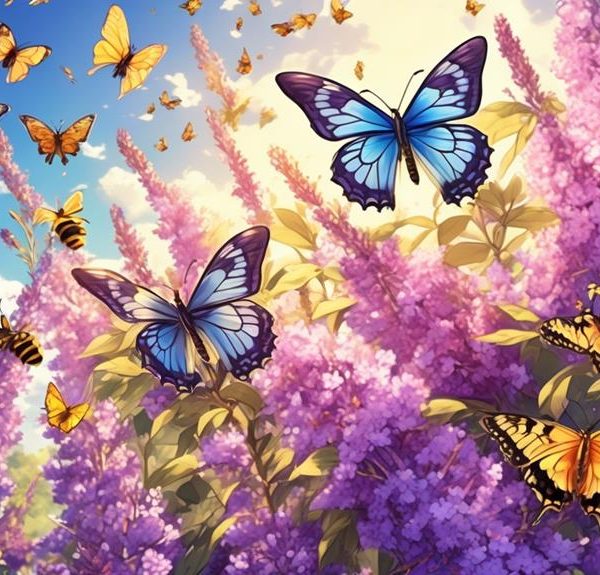Marvel at the complex relationship between bees and poppies, a vibrant interaction shaping gardening choices and bee conservation efforts.
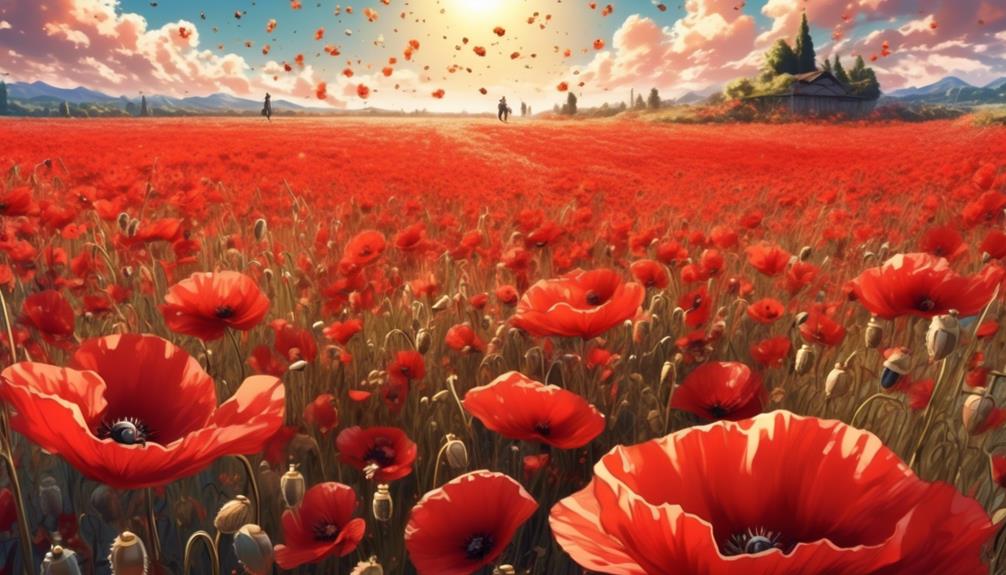
Do Bees Like Poppies?
You might not realize that the seemingly innocuous poppy, often associated with Remembrance Day, could play a significant role in the survival of bees.
As a bee enthusiast or gardener, you've probably wondered what flowers are best for attracting these industrious pollinators. Poppies, with their vibrant colors and ample pollen, might seem like an obvious choice.
However, the relationship between bees and poppies isn't as straightforward as you might think. Intriguing observations and scientific research suggest a complex interaction worth exploring further – an interaction that could potentially shape your gardening choices and impact bee conservation efforts.
Key Takeaways
- Bees are attracted to poppies because they provide a rich source of nectar and pollen, essential nutrients for their survival.
- Poppies have evolved to attract bees with their bright colors, strong scent, and easily accessible nectar and pollen.
- Beekeepers have observed that bees prioritize poppies over other flowers, as they offer a reliable and energy-rich food source.
- Bees and poppies have a mutual dependency for survival, highlighting the importance of conservation efforts that consider their interconnectedness.
Understanding Bees' Attraction to Flowers
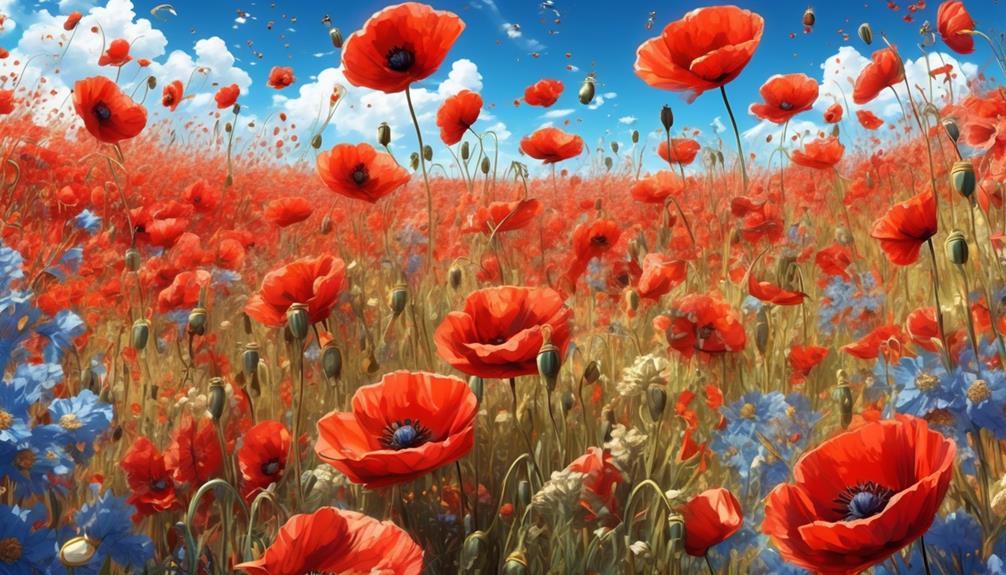
Bees' attraction to flowers, specifically poppies, stems from their innate search for nectar and pollen, essential nutrients they need to survive and thrive. As a beekeeper, you'll often observe this particular behavior. But why poppies? Poppies, like many flowers, produce a significant amount of nectar and pollen, making them a rich source of food for bees.
Poppies' bright colors and distinct scent also play a role in attracting bees. Bees have an exceptional ability to see ultraviolet light, which makes the vibrant colors of poppies particularly appealing to them. While humans see poppies as red, orange, or yellow, bees see them as glowing beacons of nourishment. Additionally, the strong scent of poppies can travel long distances, luring bees from afar.
Moreover, the shape of poppies makes it easy for bees to access the nectar and pollen. The wide, shallow shape of poppy flowers allows bees to land and navigate easily. In contrast, flowers with deep, narrow shapes can be more challenging for bees to extract nutrients from.
Understanding bees' attraction to flowers like poppies can provide insights into their foraging behavior, contributing to effective beekeeping and conservation strategies.
Poppies: A Brief Overview
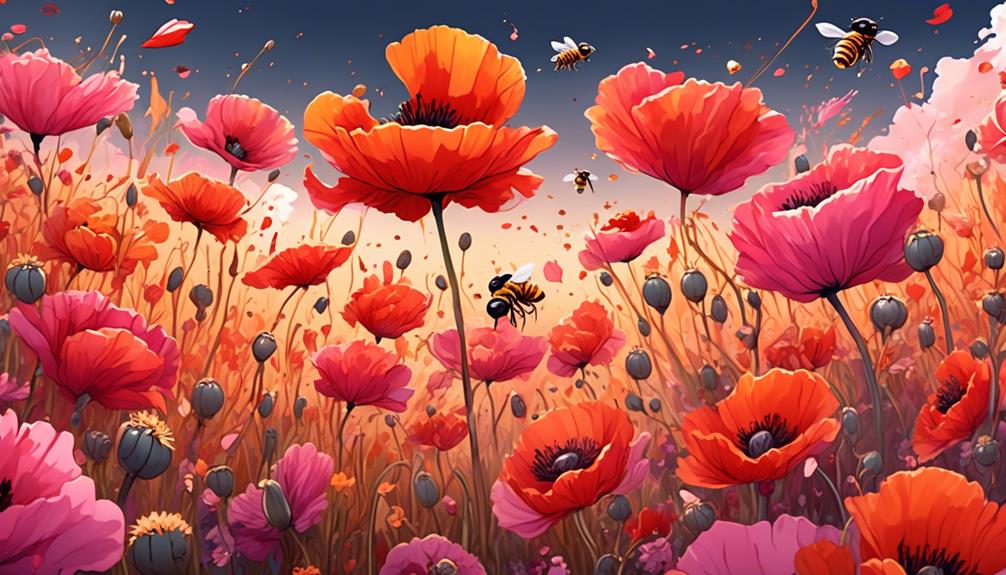
Now that we've explored why bees are drawn to poppies, let's take a closer look at these fascinating flowers themselves.
Poppies, scientifically known as Papaveraceae, are herbaceous plants often recognized for their vibrant, showy flowers. They're native to several parts of the world, including Eurasia, Africa, and North America.
These plants can grow up to five feet tall, with flowers that reach up to six inches in diameter. Poppies don't just offer aesthetic appeal; they're also crucial in certain industries. For instance, the opium poppy is a key ingredient in many pharmaceutical products, while other types are used in the culinary world for their seeds and oil.
Poppies possess a unique pollination strategy. Unlike many other flowers that rely on nectar as a lure, poppies attract pollinators with their intense colors and large, accessible pollen stores. The pollen-rich anthers of poppies are exposed, facilitating easy access for bees.
Poppies are hardy and can thrive in various conditions, but they prefer full sun and well-drained soil.
As you can see, poppies are much more than beautiful blossoms; they're complex organisms playing significant roles in ecosystems and human industries alike.
The Science Behind Bees and Poppies
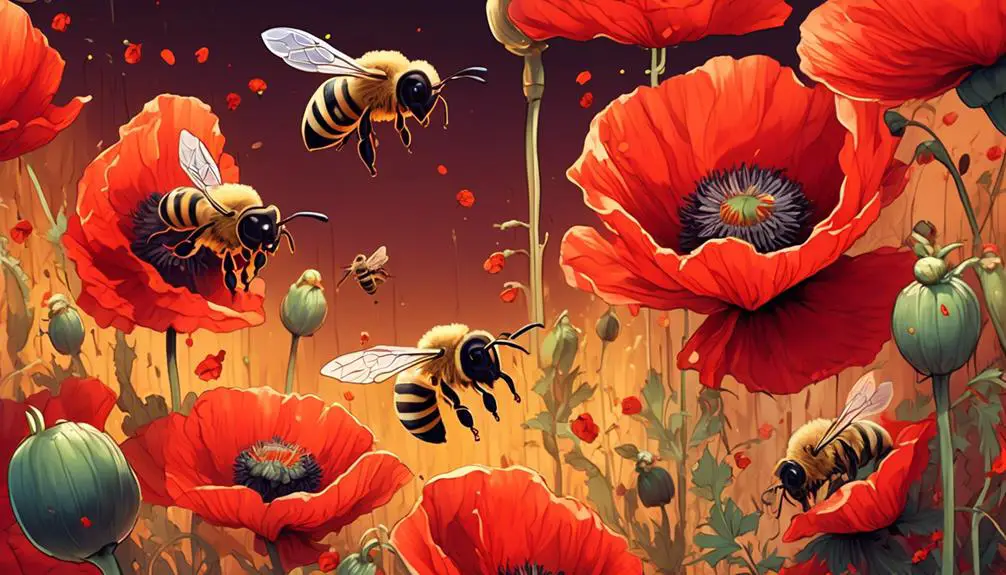
To truly appreciate the intricate relationship between bees and poppies, it's crucial to delve into the captivating science behind their interaction.
Poppies, like other flowers, have evolved to attract pollinators. They do so by offering bees nectar, a sweet reward for the essential pollination service bees provide.
When bees approach poppies, they're drawn to the vibrant colors and strong scent. You see, bees perceive color differently than we do. They can't see red but are sensitive to ultraviolet light, which poppies reflect. This UV reflection creates a bullseye effect, guiding bees to the nectar source.
Poppies also secrete nectar in a unique way. Instead of having a deep reservoir like many flowers, poppies have a ring of nectar-producing cells around their base. Bees must crawl into the flower, brushing against pollen-laden anthers, in order to access the nectar.
The pollen sticks to the bee's fuzzy body, and when the bee visits the next flower, some of it rubs off, fertilizing the flower. This is a brilliant example of mutualism – both the bee and poppy benefit from this interaction.
Observations From Beekeepers
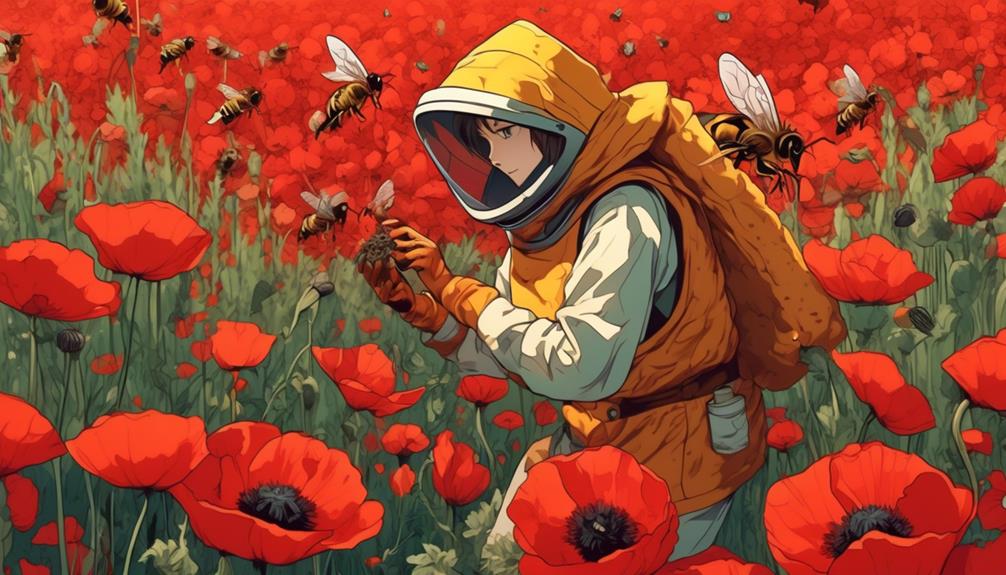
Drawing from their wealth of experience, beekeepers have observed firsthand the magnetic attraction poppies hold for bees. You'll see bees buzzing around these vibrant flowers, their tiny bodies dusted with pollen, their nectar sacs bulging. It's clear that poppies are a prime source of sustenance for these industrious creatures.
Beekeepers have noted that bees will often prioritize poppies over other nearby flowers. This isn't just a random preference. Poppies produce a rich, sugary nectar that's a high-energy food source for the bees. Moreover, the pollen from poppies is packed with protein, a critical component of bee diets.
From an analytical perspective, bees' affinity for poppies makes sense. Bees, like all organisms, aim to maximize their energy intake. Poppies, with their generous nectar and pollen offerings, provide a reliable, energy-rich food source. It's a simple, yet effective survival strategy.
However, it's not just about survival. Observations also suggest that bees might have an innate preference for the bright colors and unique petal patterns of poppies. In the world of bees, it appears that poppies are more than just a meal – they're also a visual feast.
Impact on Bee and Poppy Conservation
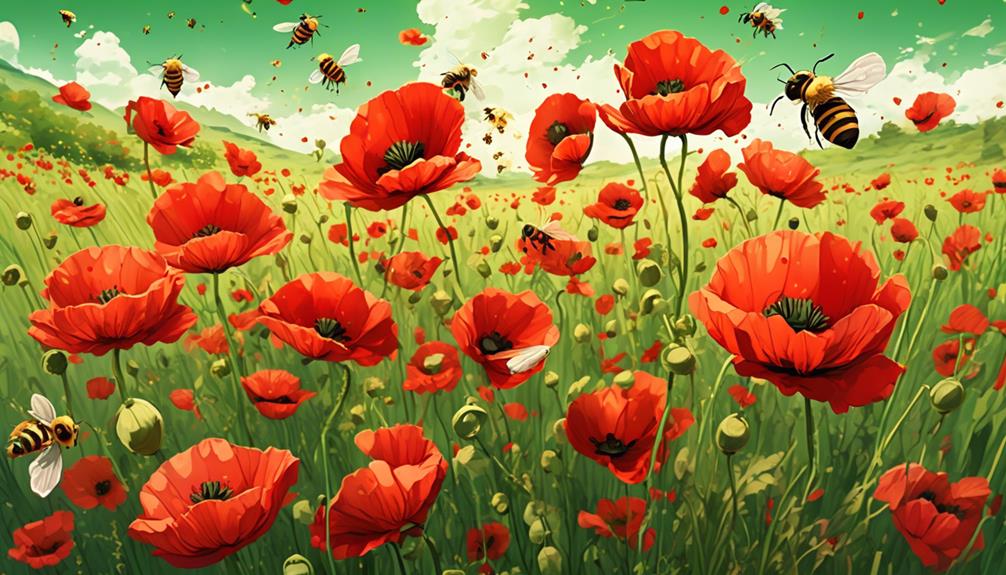
Understanding the symbiotic relationship between bees and poppies can significantly influence conservation strategies for both these vital species. As you delve deeper into this relationship, you'll notice that bees rely on poppies for nectar and pollen while the poppies need bees for pollination. It's a mutual dependency that's crucial for their survival.
However, both species currently face significant threats. Bees are grappling with habitat loss, pesticide exposure, and climate change. These factors lead to declining bee populations, which in turn affects poppy pollination. Poppies, on the other hand, also face habitat loss due to urbanization and agricultural practices.
Conservation strategies should, therefore, factor in the interconnectedness of bees and poppies. You can't conserve bees without considering the plants they depend on and vice versa. For instance, creating pollinator-friendly habitats with a variety of flowering plants, including poppies, can offer bees the necessary food and shelter. Simultaneously, reducing pesticide use can lower the risk to bees and promote poppy growth.
In essence, understanding and addressing the mutual needs of bees and poppies can go a long way in conserving these vital species and maintaining biodiversity.
Practical Implications for Gardeners

As a gardener, you're in a unique position to bolster both bee and poppy populations by implementing certain strategies in your garden. Planting poppies can attract bees, promoting pollination, and supporting biodiversity.
To help, we've created this simple table of actions:
Strategy | Benefit to Bees | Benefit to Poppies |
|---|---|---|
Plant diverse poppy species | Increases food diversity | Promotes genetic diversity |
Avoid pesticides | Enhances bee health | Improves poppy growth |
Provide a water source | Prevents bee dehydration | Assists poppy hydration |
Implementing these changes offers tangible benefits. Diverse poppy species provide variation in bee nutrition, which can bolster their populations. Pesticide avoidance reduces bee mortality rates, benefiting their health. Providing a water source can prevent bee dehydration, especially during hot summer months. This also facilitates poppy hydration, promoting their growth.
Aside from the ecological benefits, you'll witness a vibrant, dynamic garden, buzzing with bees and blooming with poppies. Investigate these strategies, understand their scientific basis, and apply them to create a garden that's not just beautiful, but also a haven for bees and a showcase for poppies. With careful planning and informed choices, you can make a significant positive impact.
Frequently Asked Questions
What Other Flowers Do Bees Prefer in Addition to Poppies?"
In addition to poppies, you'll find bees buzzing around a variety of flowers. They're particularly drawn to plants like lavender, sunflowers, and clover because of their high nectar content.
Bees also love blue, purple, and yellow flowers, so if you're looking to attract them, consider planting aster, geraniums, or black-eyed Susans.
Are There Specific Types of Bees That Are More Attracted to Poppies Than Others?"
You're asking if certain bee species prefer poppies more than others. Studies show that bees, in general, are attracted to poppies due to their vibrant colors and rich nectar.
However, it's important to note that preferences can vary. For instance, honeybees might show a stronger predilection for poppies compared to other species. It's a complex interplay of factors, not just the flower type, that determines a bee's preference.
What Time of Year Are Bees Most Attracted to Poppies?"
You're most likely to see bees buzzing around poppies during late spring and early summer. That's when poppies are in full bloom and offer the most nectar and pollen, which bees need for survival.
However, weather can affect this timing, so it's not an exact science. Remember, bees' attraction to flowers also depends on other factors such as the availability of other flowers and the specific preferences of different bee species.
Can the Attraction of Bees to Poppies Impact Other Plant Species in the Ecosystem?"
Yes, the attraction of bees to poppies can impact other plant species in the ecosystem. When bees pollinate poppies, they carry pollen to other plants, aiding in cross-pollination. This can lead to greater biodiversity.
However, if bees prefer poppies over other flowers, some plants may not receive enough pollination, potentially affecting their survival. It's a delicate balance you've got to consider in the wider scope of ecosystem health.
How Does Climate Change Affect the Relationship Between Bees and Poppies?"
Climate change affects bee-poppies relationships in significant ways.
As temperatures rise, poppies may bloom earlier or later than usual. This disrupts the timing of when bees can gather nectar and pollen.
Additionally, extreme weather can damage poppy populations, reducing food sources for bees.
You'd need to consider these factors in your research to fully understand the complex interactions between climate change, bees, and poppies.
Conclusion
So, do bees like poppies? You bet they do! Poppies, with their alluring scent and vibrant hue, are a bee's paradise. Observations and scientific studies confirm this.
It's a relationship driving conservation efforts for both bees and poppies. For you, the gardener, planting poppies could make your garden a buzzing haven.
So, let's promote this natural alliance – for the sake of our bees, our poppies, and ultimately, our ecosystems.


